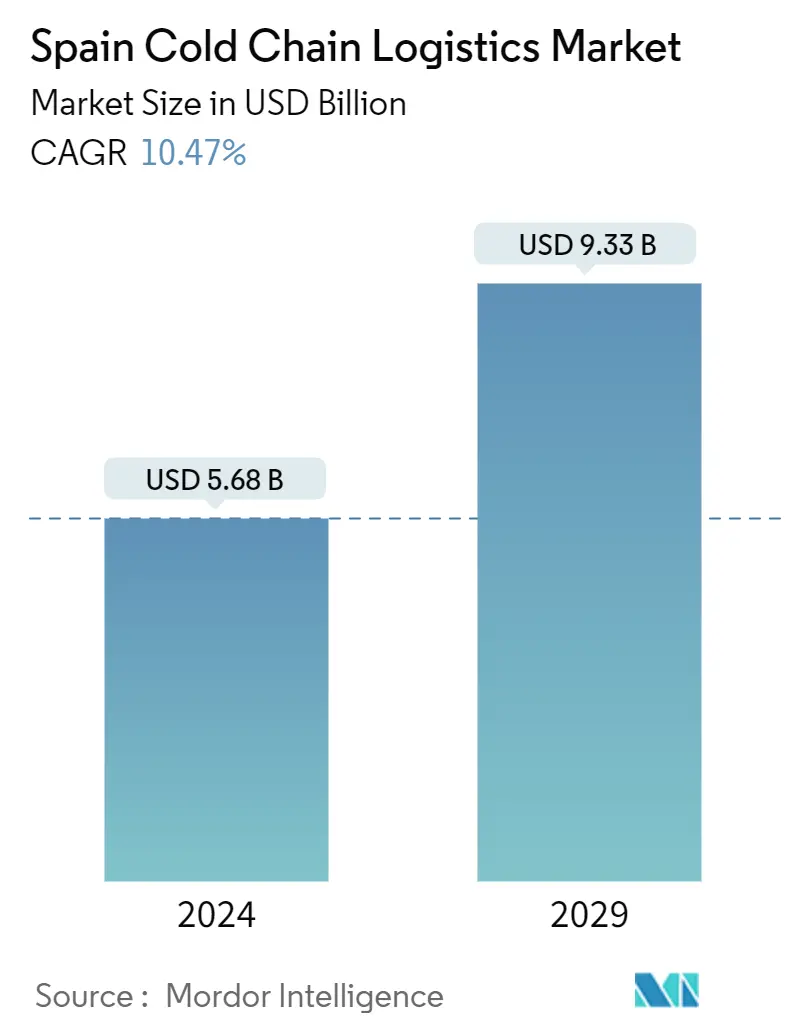Market Size of Spain Cold Chain Logistics Industry

| Study Period | 2020 - 2029 |
| Base Year For Estimation | 2023 |
| Market Size (2024) | USD 5.68 Billion |
| Market Size (2029) | USD 9.33 Billion |
| CAGR (2024 - 2029) | 10.47 % |
| Market Concentration | Low |
Major Players
*Disclaimer: Major Players sorted in no particular order |
Spain Cold Chain Logistics Market Analysis
The Spain Cold Chain Logistics Market size is estimated at USD 5.68 billion in 2024, and is expected to reach USD 9.33 billion by 2029, growing at a CAGR of 10.47% during the forecast period (2024-2029).
The main growth drivers of the market are the growth of warehousing facilities across Spain, the development of B2C e-commerce, and the increase in investment by public and private enterprises in infrastructure development. With the significant transformation in the frozen food industry, cold chain logistics has become more important due to increased investment by large enterprises. The Spanish cold chain logistics market is mainly driven by increased government investment, changes in customer preferences, and the growth of the country's pharmaceutical industry. To accelerate the improvement of logistics and transportation, the Spanish government has carried out structural reforms to promote trade and foreign investment.
With the rapid growth of the e-commerce sector and the increasing expectations of customers for same-day delivery and same-hour delivery, Spain's demand for logistics space may continue to grow in the next few years. The increase in market penetration, the rise in security and privacy of online shopping, the shortening of delivery time, and the decrease in logistics costs in the next few years may further promote the development of the logistics industry in Spain. Large service providers are expected to adopt warehouse management systems, big data analysis, and transportation management systems to maintain market competitiveness. Companies are likely to further invest in technologies, such as artificial intelligence, RFID, GPS tracking, and automation, which will contribute to the overall development of the Spanish cold chain logistics industry.
The growth in imports and exports of Spanish goods, the growth of air cargo, the increase in the number of companies in the transportation industry, and the transportation and infrastructure expenditures of container ports are some of the other key factors that may have a positive impact on the Spanish cold chain logistics market.
Spain Cold Chain Logistics Industry Segmentation
A cold chain is a temperature-controlled supply chain. Cold chain logistics is the technology and process that allows the safe transport of temperature-sensitive goods and products along the supply chain. A complete background analysis of the Spanish cold chain logistics market, including the assessment of the economy and contribution of sectors in the economy, a market overview, market size estimation for key segments, emerging trends in the market segments, market dynamics, and geographical trends, and COVID-19 impact, is covered in the report.
The Spanish cold chain logistics market is segmented by services (storage, transportation, and value-added services (blast freezing, labeling, inventory management, etc.), temperature type (ambient, chilled, and frozen), and application (horticulture (fresh fruits and vegetables), dairy products (milk, ice cream, butter, etc.), meat and fish, processed food products, pharmaceuticals, life sciences, chemicals, and other applications). The report offers market size and forecast values (USD) for all the above segments.
| By Services | |
| Storage | |
| Transportation | |
| Value-added Services (Blast Freezing, Labeling, Inventory Management, etc.) |
| By Temperature Type | |
| Ambient | |
| Chilled | |
| Frozen |
| By Application | |
| Horticulture (Fresh Fruits and Vegetables) | |
| Dairy Products (Milk, Ice-cream, Butter, etc.) | |
| Meats and Fish | |
| Processed Food Products | |
| Pharma, Life Sciences, and Chemicals | |
| Other Applications |
Spain Cold Chain Logistics Market Size Summary
The Spain cold chain logistics market is poised for significant growth, driven by the expansion of warehousing facilities, the burgeoning B2C e-commerce sector, and increased investments in infrastructure by both public and private entities. The transformation within the frozen food industry has underscored the importance of cold chain logistics, with substantial investments from large enterprises further propelling the market. Government initiatives aimed at enhancing logistics and transportation infrastructure, alongside structural reforms to boost trade and foreign investment, are key contributors to the market's expansion. The pharmaceutical industry's growth, coupled with changing consumer preferences, also plays a crucial role in driving demand for cold chain logistics solutions in Spain.
As Spain continues to solidify its position as a major player in the European e-commerce landscape, the demand for logistics space is expected to rise, fueled by consumer expectations for rapid delivery services. The market is characterized by technological advancements, with large service providers adopting sophisticated warehouse management systems, big data analytics, and transportation management systems to maintain competitiveness. Investments in technologies such as artificial intelligence, RFID, GPS tracking, and automation are anticipated to enhance the efficiency and effectiveness of cold chain logistics operations. The market's growth is further supported by increased imports and exports, the expansion of air cargo, and investments in transportation and infrastructure, particularly in container ports. The presence of numerous players in the market, along with strategic partnerships and acquisitions, underscores the competitive landscape, with companies striving to capture a larger share of the market through innovation and expansion.
Spain Cold Chain Logistics Market Size - Table of Contents
-
1. MARKET INSIGHTS DYNAMICS
-
1.1 Current Market Scenario
-
1.2 Market Overview
-
1.3 Market Dynamics
-
1.3.1 Drivers
-
1.3.1.1 Increase in Demand for Perishable Goods
-
1.3.1.1.1 Growth in the E-commerce Industry
-
-
-
1.3.2 Restraints
-
1.3.2.1 Higher Capital Investment
-
1.3.2.1.1 Infrastructure Limitations
-
-
-
1.3.3 Opportunities
-
1.3.3.1 Integration of Advanced Technologies
-
-
-
1.4 Value Chain / Supply Chain Analysis
-
1.5 Industry Attractiveness - Porter's Five Forces Analysis
-
1.5.1 Bargaining Power of Buyers/Consumers
-
1.5.2 Bargaining Power of Suppliers
-
1.5.3 Threat of New Entrants
-
1.5.4 Threat of Substitute Products
-
1.5.5 Intensity of Competitive Rivalry
-
-
1.6 Technological Trends and Automation
-
1.7 Government Regulations and Initiatives
-
1.8 Industry Value Chain/Supply Chain Analysis
-
1.9 Spotlight on Ambient/Temperature-controlled Storage
-
1.10 Impact of Emission Standards and Regulations on the Cold Chain Industry
-
1.11 Impact of COVID-19 on the Market
-
-
2. MARKET SEGMENTATION
-
2.1 By Services
-
2.1.1 Storage
-
2.1.2 Transportation
-
2.1.3 Value-added Services (Blast Freezing, Labeling, Inventory Management, etc.)
-
-
2.2 By Temperature Type
-
2.2.1 Ambient
-
2.2.2 Chilled
-
2.2.3 Frozen
-
-
2.3 By Application
-
2.3.1 Horticulture (Fresh Fruits and Vegetables)
-
2.3.2 Dairy Products (Milk, Ice-cream, Butter, etc.)
-
2.3.3 Meats and Fish
-
2.3.4 Processed Food Products
-
2.3.5 Pharma, Life Sciences, and Chemicals
-
2.3.6 Other Applications
-
-
Spain Cold Chain Logistics Market Size FAQs
How big is the Spain Cold Chain Logistics Market?
The Spain Cold Chain Logistics Market size is expected to reach USD 5.68 billion in 2024 and grow at a CAGR of 10.47% to reach USD 9.33 billion by 2029.
What is the current Spain Cold Chain Logistics Market size?
In 2024, the Spain Cold Chain Logistics Market size is expected to reach USD 5.68 billion.

